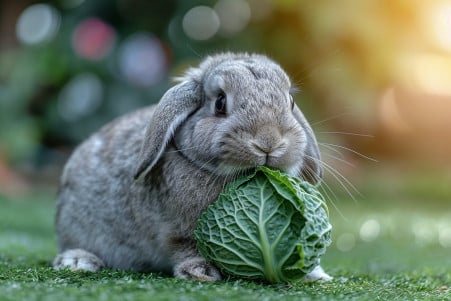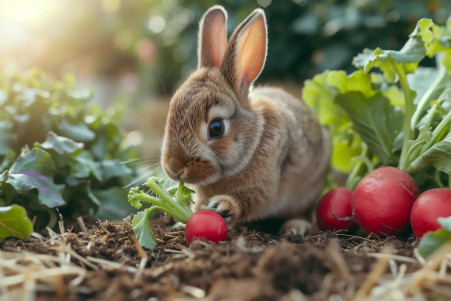Can Rabbits Eat Lettuce? Understanding the Do’s and Don’ts
26 January 2024 • Updated 28 January 2024

Rabbits are often shown eating lettuce, but is it really the best option for them? Lettuce is safe for rabbits to eat, especially romaine, red or green leaf, and butterhead lettuces, all of which have nutritional value. Iceberg lettuce, on the other hand, is not a good option because it has little nutritional value and can cause diarrhea. Lettuce should be fed to rabbits in moderation.
In the sections below, we will review extensive research from veterinary science, animal nutrition, and botany to help you understand the place of lettuce in a rabbit’s diet. We will look at research on digestive health and nutritional value, and we will also consult with rabbit experts. This will help us provide you with a comprehensive understanding of how to safely and nutritiously include lettuce in your rabbit’s diet.
Can rabbits eat lettuce?
What Do Rabbits Eat? More Than Just Lettuce
While the image of a rabbit munching on a piece of lettuce may seem simple, a rabbit’s diet is anything but. According to Rabbit.org, hay is the foundation of a rabbit’s diet and should make up about 80% of what they eat each day. Rabbits need hay to help with digestion and to keep their teeth at the right length.
In addition to hay, an adult rabbit’s diet should include a variety of vegetables, including different types of lettuce, which should make up about 10% of what they eat and help them get the vitamins and minerals they need.
While rabbits can eat leafy greens like romaine lettuce, the RSPCA recommends that any new vegetables be introduced slowly to avoid upsetting a rabbit’s stomach. The RSPCA also stresses that rabbits should be fed a diet that’s high in fiber from hay, with a small amount of vegetables and an even smaller amount of fruits and treats.
To make sure your rabbit’s diet is well-rounded, The Educated Rabbit suggests that you feed your rabbit a variety of vegetables, including different types of lettuce. They recommend that vegetables make up 15–20% of a rabbit’s diet, which comes out to about 2 cups per 6 pounds of body weight each day, split between two meals.
In order to make sure your rabbit is getting a well-rounded diet, it’s important to make sure they’re eating a variety of hays, a mix of vegetables, and a small amount of fruits. Not only will a well-rounded diet make sure your rabbit is getting the nutrients they need, but it will also help them exhibit natural foraging behaviors, which will help keep them physically and mentally healthy.
The Nutritional Content of Lettuce
Lettuce is often maligned for its lack of nutritional value. However, a thorough review published in PMC notes that lettuce is a good source of water, vitamins, minerals, and bioactive compounds, including polyphenols and carotenoids.
In particular, red lettuce has higher levels of vitamin C and other antioxidants, and higher phenolic content than green lettuce. Meanwhile, a review published in ScienceDirect points out that lettuce is low in calories and fat and a good source of fiber, iron, folate, and vitamin C.
Lettuce with darker leaves, such as romaine, is more nutritious than iceberg lettuce, which is lower in minerals and vitamins.
It’s important to note that not all lettuces are created equal, and this is a myth that needs to be dispelled. The lettuces that are safe for rabbits to eat, such as romaine, are nutritious and a good source of fiber.
On the other hand, while iceberg lettuce isn’t without nutritional value, it’s less nutritious and has a higher water content, which can be problematic. Knowing these nutritional differences and what they mean for rabbits can help pet owners decide whether and how to responsibly include lettuce in their pets’ diets.
How to Safely Feed Lettuce to Your Rabbit: Dangers and Precautions
While lettuce can be a part of your rabbit’s diet, there are some precautions to keep in mind. For example, Oxbow Animal Health does not recommend feeding rabbits iceberg lettuce. This type of lettuce contains lactucarium, which can be toxic in large amounts, and it’s high in water and low in nutrients. Feeding rabbits iceberg lettuce can lead to diarrhea and, in the worst-case scenario, contribute to GI stasis.
When feeding any new vegetable, including safe types of lettuce like romaine or leaf lettuce, VCA Animal Hospitals recommends starting with a small amount to avoid disrupting the rabbit’s sensitive digestive system. Slowly increase the amount over the course of a few days while watching your rabbit for changes in behavior and stool.
Oxbow Animal Health recommends feeding rabbits a mix of 3 to 5 different vegetables each day to prevent overconsumption and ensure a well-rounded diet. Always wash vegetables thoroughly to remove any potential toxins. If your rabbit shows any signs of digestive upset or changes in appetite, make sure to check in with a vet who specializes in rabbits to make sure there isn’t an adverse reaction to the new diet.
Properly introducing lettuce will not only help diversify your rabbit’s diet but also keep them healthy and ready for a diet that’s high in fiber—which is important for their digestive health.
The Fiber Factor: Why Fiber Is So Important for Rabbits
Rabbits have a unique digestive system that has evolved to help them get the most out of their high-fiber, plant-based diet. One of the most important parts of this system is a process called “double digestion.” After food is initially digested in the stomach, it moves to the cecum, where it is fermented by beneficial bacteria.
This fermentation process creates cecotropes that are full of nutrients that the rabbit can then re-ingest, ensuring that they get the most out of the food they eat, according to Kavee Cage’s rabbit health study.
Fiber is a critical part of this process. A study in ScienceDirect notes that dietary fibers are a necessary part of rabbit diets and are especially important in helping to reduce the risk of digestive problems after weaning. The right amount of fiber in a rabbit’s diet helps ensure that food moves through their digestive system at the right pace and helps maintain mucosal health, which is important for overall digestive health.
Lettuce, including romaine, is high in fiber, which makes it a good choice for rabbits. It helps provide the bulk and roughage that rabbits need to keep their digestive systems moving smoothly. If rabbits don’t get enough fiber in their diets, they can develop digestive problems, including GI Stasis, according to Kavee Cage’s research.
GI Stasis is a serious condition in which the digestive system slows down or stops working altogether. So, by including high-fiber lettuces like romaine in a rabbit’s diet, you can help ensure that their complex digestive system stays healthy and that they avoid serious health problems.
Balancing Hydration with Nutrition: Lettuce in a Rabbit’s Diet
In addition to a balanced diet, rabbits require hydration to maintain their health. A rabbit’s body is made up of approximately 60% water, so it’s important for their physiological processes.
In fact, one study found that rabbits on a dry diet drank a significant amount of water, indicating that they need to stay hydrated. Lettuce can help rabbits stay hydrated because it has a high water content.
However, not all lettuces are created equal in this regard. Iceberg lettuce, for example, has a high water content but lacks the nutritional value that’s good for rabbits, and it can even lead to dilutional diarrhea if it’s eaten in large quantities.
To make sure rabbits get the hydration and nutrition they need from their leafy greens, it’s important to choose lettuces like romaine that have both water and nutrients. One study even found that adding leafy greens with long fibers to a rabbit’s diet can help support health and digestive complexity, something that’s reflected in Supreme Petfoods’ new recipes.
When feeding rabbits lettuce, it’s important to make sure it’s balanced with drier, fibrous foods like hay to make sure the rabbit’s gut stays healthy overall and that they get the hydration they need without sacrificing their nutrition.
Conclusion: Can Rabbits Eat Lettuce?
So, can rabbits eat lettuce? Yes, but it’s important to make sure you’re choosing the right types of lettuce to ensure that you’re supporting your rabbit’s health.
Leafy greens like romaine, green leaf, and butter lettuce are the best options because they offer a variety of nutrients, including important vitamins and fiber. On the other hand, iceberg lettuce is not a good option because it doesn’t offer many nutrients and can lead to digestive issues.
According to Rabbit.org, a rabbit’s diet should be made up mostly of hay, with vegetables like lettuce making up a smaller portion of their daily intake. The RSPCA recommends that rabbit owners introduce new foods like lettuce to their pets’ diets slowly so they can keep an eye out for any negative side effects.
It’s also important to make sure that rabbits are getting a variety of foods so that they can get a range of nutrients without consuming too many sugary or watery foods.
As a responsible pet owner, it’s important to make sure that you understand and meet your rabbit’s specific dietary needs. By doing so, you can make sure that you’re supporting your rabbit’s health and well-being, preventing issues like nutritional deficiencies and digestive upset, and helping them live a long, happy life.


